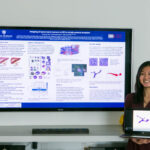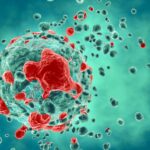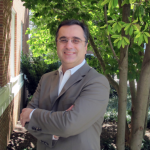‘Just add water’ to activate freeze-dried brain cancer fighting nanoparticles
Biomedical engineers and clinicians at Johns Hopkins University have developed freeze-dried nanoparticles made of a shelf-stable polymer that only need the addition of water to activate their cancer-fighting gene therapy capabilities.
Principal investigator Jordan Green, assistant professor in the department of Biomedical Engineering at the Johns Hopkins School of Medicine, led the team that fabricated the polymer-based particles measuring 80 to 150 nanometers in diameter. Each particle, which is about the size of a virus, has the ability to carry a genetic cocktail designed to produce brain cancer cell-destroying molecules. After manufacture, the nanoparticles can be stored for up to 90 days before use. In principle, cancer therapies based on this technology could lead to a convenient commercial product that clinicians simply activate with water before injection into brain cancer tumor sites.
Because this method avoids the common, unpleasant side effects of traditional chemotherapy, “nanoparticle-based gene therapy has the potential to be both safer and more effective than conventional chemical therapies for the treatment of cancer,” Green said. But, he added current gene therapy nanoparticle preparations are just not practical for clinical use.
“A challenge in the field is that most non-viral gene therapy methods have very low efficacy. Another challenge with biodegradable nanoparticles, like the ones used here is that particle preparation typically takes multiple time-sensitive steps.” Green said. “Delay with formulation results in polymer degradation, and there can be variability between batches. Although this is a simple procedure for lab experiments, a clinician who wishes to use these particles during neurosurgery will face factors that would make the results unpredictable.”
In contrast, the nanoparticles developed by the Green lab are a freeze-dried, or “lyophilized,” formulation. “A clinician would simply add water, and it is ready to inject,” Green said. Green thinks this freeze-dried gene-delivery nanoparticle could be easily manufactured on a large scale.
Co-investigator Alfredo Quinones-Hinojosa, a Johns Hopkins Hospital clinician-scientist and associate professor in the departments of Neurosurgery and Oncology at the Johns Hopkins School of Medicine, said he could imagine particles based on this technology being used in conjunction with, and even instead of, brain surgery. “I envision that one day, as we understand the etiology and progression of brain cancer, we will be able to use these nanoparticles even before doing surgery,” Quinones said. “How nice would that be? Imagine avoiding brain surgery all together!”
Currently, patients with glioblastoma, or brain cancer, only have a median survival of about 14 months, Green said. “Methods other than the traditional chemotherapy drugs and radiation—or in combination with them—may improve prognosis,” he said.
Gene therapy approaches could also be personalized, Green said. “Because gene therapy can take advantage of many naturally-existing pathways and can be targeted to the cancer type of choice through nanoparticle design and transcriptional control, several levels of treatment specificity could be provided,” Green said.
The nanoparticles self-assemble from a polymer structural unit, so fabrication is fairly simple, said Green. Finding the right polymer to use, however, proved to be a challenge. Lead author Stephany Tzeng, a PhD student in biomedical engineering in Green’s lab screened an assortment of formulations from a “polymer library” before hitting on a winning combination.
“One challenge with a polymer library approach is that there are many polymers to be synthesized and nanoparticle formulations to be tested. Another challenge is designing the experiments to find out why the lead formulation works so well compared to other similar polymers and to commercially available reagents,” Green said.
Tzeng settled on a particular formulation of poly(beta-amino ester)s specifically attracted to glioblastoma (GB) cells and to brain tumor stem cells (BTSC), the cells responsible for tumor growth and spread. “Poly(beta-amino ester) nanoparticles are generally able to transfect many types of cells, but some are more specific to GBs and BTSCs,” Tzeng said.
The nanoparticles work like a virus, co-opting the cell’s own protein-making machinery, but in this case, to produce a reporter gene (used to delineate a tumor’s location) or new cancer fighting molecule. “It is possible that glioblastoma-derived cells, especially brain tumor stem cells, are more susceptible to our gene delivery approach because they divide much faster,” Tzeng added.
Not only are the particles convenient to use, the team discovered that dividing cells continued to make the new protein for as long as six weeks after application. “The gene expression peaked within a few days, which would correspond to a large initial dose of a therapeutic protein,” said Green. “The fact that gene expression can continue at a low level for a long time following injection could potentially cause a sustained, local delivery of the therapeutic protein without requiring subsequent injection or administration. The cells themselves would act as a ‘factory’ for the drug.”
Once the nanoparticles release their DNA cargo, Tzeng said the polymer quickly degrades in water, usually within days. “From there, we believe the degradation products are processed and excreted with other cellular waste products,” Tzeng said.
Members of the Green Lab are now working on identifying the intracellular mechanism responsible for facilitating cell-specific delivery. “We also plan to build additional levels of targeting into this system to make it even more specific. This includes modifying the nanoparticles with ligands to specifically bind to glioblastoma cells, making the DNA cargo able to be expressed only in GB cells, and using a DNA sequence whose product is only effective in GB cells.”
So far, the team has only successfully transfected brain tumor stem cells using these nanoparticles in a plastic dish. The next step is to test the particle in animal models.
“We hope to begin tests in vivo in the near future by implanting brain tumor stem cells into a mouse and injecting particles. We also hope to begin using functional genes that would kill cancer cells in addition to the fluorescent proteins that serve only as a marker,” Tzeng said.
Other authors who contributed to this work are Hugo Guerrero-Cázares, postdoctoral fellow in Neurosurgery and Oncology, and Joel Sunshine, an M.D.-Ph.D. candidate, and Elliott Martinez, an undergraduate leadership alliance summer student, both from Biomedical Engineering. Funding for this work came from the National Institutes of Health, Howard Hughes Medical Institute, the Robert Wood Johnson Foundation and a pilot-grant from Johns Hopkins Institute for NanoBioTechnology (INBT). Green is an affiliated faculty member of INBT. The research will be published in Issue #23 (August 2011) of the journal Biomaterials and is currently available online.
Freeze-dried gene therapy system avoids virus, complications
Story by Mary Spiro
Latest Posts
-
 Q&A with PSON Intern Jocelyn Hsu
August 19, 2021
Q&A with PSON Intern Jocelyn Hsu
August 19, 2021
-
 Start Up Founders from Johns Hopkins Aim to Stop Spread of Cancer
August 3, 2021
Start Up Founders from Johns Hopkins Aim to Stop Spread of Cancer
August 3, 2021
-
 Protein Appears to Prevent Tumor Cells from Spreading Via Blood Vessels
July 15, 2021
Protein Appears to Prevent Tumor Cells from Spreading Via Blood Vessels
July 15, 2021


